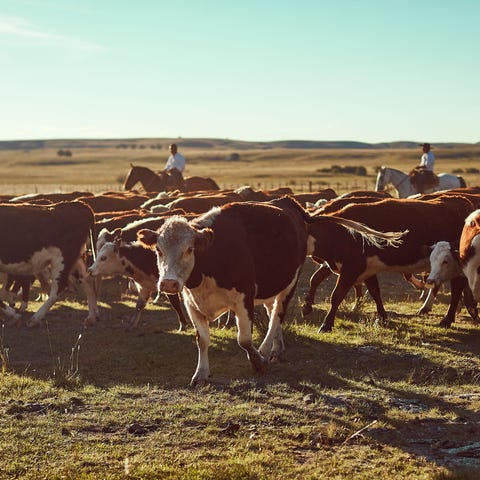For the most delicious beef, you may have to hunt around the grocery store or butcher shop and find what the cow you’re about to eat … ate.
“The flavor of the beef reflects what the cattle eat. Conventional, factory farmed beef is uniform in its flavor profile,” says Dana Ehrlich, CEO and founder of Verde Farms, a grass-fed beef company. “Grass-fed can vary depending on the grasslands, the breed, and even the weather.”
Sure, Ehrlich makes his bones selling grass-fed beef, but you don’t have to take him at his word. If you’ve been curious about how grass-fed beef compares to grain-fed beef, taste-test a grass-fed rib eye next to an identical cut of grain-fed, both cooked the exact same way. The flavor between the two, you’ll soon witness, will taste as different as a crumbly, sharp Vermont cheddar and a shrink-wrapped slice of American cheese.

Igancio Seijo
Making the change from grain-fed beef to grass-fed beef is like moving from Wonder Bread to a crusty French baguette.
They’re that different.
The cleaner, richer flavor and almost velvety texture of grass-fed beef is so elementally pure that the cuts rarely need any special treatment or toppings, making them easy to work with at home or on the grill.
Increase your grass-fed beef IQ with this grass-fed guide from Ehrlich and his team at Verde Farms.
What does grass-fed beef mean?
It’s all about what the cattle eat. Grass-fed beef means cattle are raised on a diet of only grass and forage for the entirety of their lives. Cattle are ruminants and grass is their natural diet, so the animals are healthier and the beef ends up extremely nutrient-dense and really delicious as a result.
Conventional beef comes from cattle that were started on grass but then switched to a diet of corn or grains. This is a cheaper and faster way to fatten the cattle. True grass-fed also means free range; the animals roaming on pasture their entire lives. Some beef that’s labeled as grass-fed beef in the supermarket actually comes from feedlot cattle that are fed grass pellets.
What are some main differences between grass-fed vs. grain-fed?
In general, grass-fed beef has a cleaner, richer flavor than grain-fed beef. It’s true beef flavor; the way it should taste and how it used to taste before factory farming. Grass-fed beef is also leaner and sometimes smaller in size as a result.

Igancio Seijo
The fat is more yellow in color as opposed to white, and it is more flavorful. The sticker price is almost always more expensive than typical grain-fed (between $1 to $3 for a pound of ground beef). That is because conventional beef supply is optimized for high volume and low price, while grass-fed optimizes for the health of the land and the animals.
So while the cost at the register might be higher, we believe that the true cost to the health of the consumer, the animal, and the planet, makes this a much better investment.
Is it healthier?
Compared to traditional grain-fed, grass-fed beef is typically lower in calories, includes more good fats, including CLA, and higher levels of essential vitamins and minerals, including beta-carotene, vitamin E, B vitamins, calcium, magnesium, and potassium.
Where can you find grass-fed beef?
Many quality grocery stores have grass-fed beef under a brand or a store label. Sometimes, but not always, you can find it at the fresh case. You can also find it online at sources like AmazonFresh. You may also find local grass-fed beef at farmer’s markets.
What cuts of grass-fed beef are best to buy?
We are partial to cuts like ribeye or strip that include a little more fat, but ground beef, chuck roast, sirloin, or any cut that you usually like to cook are great as well. There’s no cut of grain-fed that doesn’t have a grass-fed counterpart.
How should I cook it?
Because grass-fed beef is leaner, it cooks more quickly. If you’re new to grass-fed beef, keep a close eye on the temperature. We recommend about 30 percent less time (or ten degrees less target temp) than you would cook typical grain-fed beef.
If you want to be extra careful, use a meat thermometer to check for your desired doneness. That’s especially important because the meat will continue cooking after you remove it from the heat.
Before cooking, take the beef out of the refrigerator. Make sure to leave it out long enough for it to come to room temperature, around 20 to 30 minutes. That helps the beef cook more evenly. We like to let the grass-fed flavor shine, so we usually brush with a little olive oil prior to grilling and stick to kosher salt and pepper for seasoning. After cooking, leave it to rest for 10 minutes to make the meat juicier and more flavorful.
Source: Read Full Article
